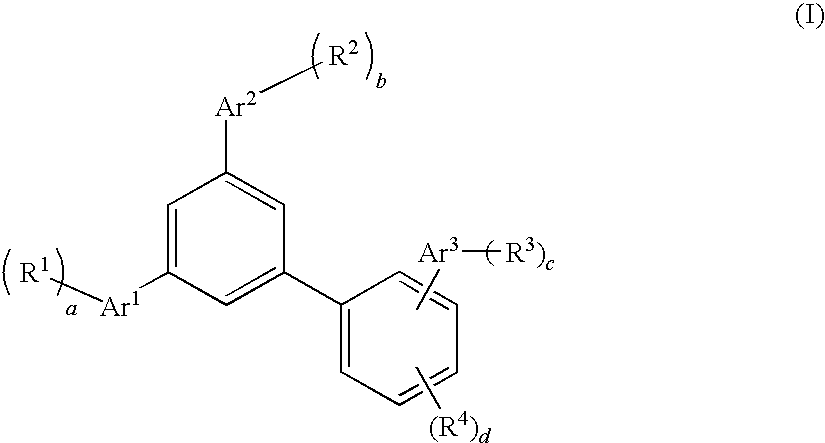Biphenyl derivative, material for organic electroluminescence device, and organic electroluminescence device using the same
a technology of organic electroluminescence and derivatives, applied in the direction of luminescnet screens, discharge tubes, organic chemistry, etc., can solve the problem that the light emitting material has not yet been evaluated
- Summary
- Abstract
- Description
- Claims
- Application Information
AI Technical Summary
Benefits of technology
Problems solved by technology
Method used
Image
Examples
synthesis example 1
Synthesis of AN-4
[0166]Under the atmosphere of argon gas, 9 g of 1-(3,5-dibromophenyl)pyrene synthesized from 3,5-diboromoiodobenzene and 1-pyrenyl boronic acid was dissolved into 100 ml of anhydrous tetrahydrofuran (THF) and cooled down to −70° C. 14 ml of 1.6M n-butyllithium hexane solution was dropped therein and the resultant was stirred for 30 minutes. 5.9 g of 1,2-diiodoethane was added therein and the resultant was stirred for 5 hours. After the resultant was left overnight, water and methylene chloride were added therein, and then sodium bisulfite was added therein until the burned umber of the reaction solution was changed to yellow. The organic layer was extracted therefrom, and then it was washed by water and saturated salt water. Subsequently the organic layer was dried by using anhydrous sodium sulfate, and then the solvent was removed by distillation. The residue was refined through a silica gel chromatography (developing solvent: toluene / hexane=1 / 3) and then 8.4 g of ...
synthesis example 2
Synthesis of AN-5
[0169]Under the atmosphere of argon gas, 6 g of tribromobenzene available as a commercial reagent, 9.4 g of 1-pyrenyl boronic acid and 0.88 g of tetrakis(triphenylphophine)palladium were dissolved in 150 ml of toluene, and then the 57 ml of 2M sodium carbonate aqueous solution was added therein, followed by 7 hours reflux on heating. After standing to cool, the precipitated solid was separated through filtration, and then followed by washing with water and methanol, and drying. The obtained solid was refined through a silica gel chromatography (developing solvent: toluene / hexane=1 / 3) and then 4.1 g of 3,5-dipyrenylbromobenzene of pale yellow solid was obtained (Yield: 38%).
[0170]Under the atmosphere of argon gas, 3.9 g of obtained 3,5-dipyrenylbromobenzene, 2.9 g of 3-(9-phenylanthracene-10-yl)phenyl boronic acid obtained by a known method and 0.16 g of tetrakis(triphenylphophine)palladium were dissolved in 80 ml of DME, and then 10 ml of 2M sodium carbonate aqueous...
synthesis example 3
Synthesis of AN-8
[0171]Under the atmosphere of argon gas, 3.5 g of 3,3′,5-tribromobiphenyl synthesized from 3,5-dibromoiodobenzene and 3-bromophenyl boronic acid, 7.3 g of 1-pyrenyl boronic acid available as a commercial reagent, and 150 ml of MDE were mixed. Subsequently, 0.52 g of tetrakis(triphenylphophine)palladium and 67 ml of 2M sodium carbonate aqueous solution were added therein, followed argon displacement. After it was refluxed for 8 hours, it was left overnight. The predipitated crystal was separated through filtration, and then followed by washing with water, methanol and heated toluene, and 4.7 g of pale yellow solid as the objective compound (AN-8) was obtained (Yield: 69%). By Field Desorption Mass Spectrometry (FD-MS) analysis of the obtained compound, m / z=754 in the case of C60H34=754 was obtained, therefore AN-8 was confirmed.
PUM
| Property | Measurement | Unit |
|---|---|---|
| wave length | aaaaa | aaaaa |
| transmittance | aaaaa | aaaaa |
| work function | aaaaa | aaaaa |
Abstract
Description
Claims
Application Information
 Login to view more
Login to view more - R&D Engineer
- R&D Manager
- IP Professional
- Industry Leading Data Capabilities
- Powerful AI technology
- Patent DNA Extraction
Browse by: Latest US Patents, China's latest patents, Technical Efficacy Thesaurus, Application Domain, Technology Topic.
© 2024 PatSnap. All rights reserved.Legal|Privacy policy|Modern Slavery Act Transparency Statement|Sitemap



